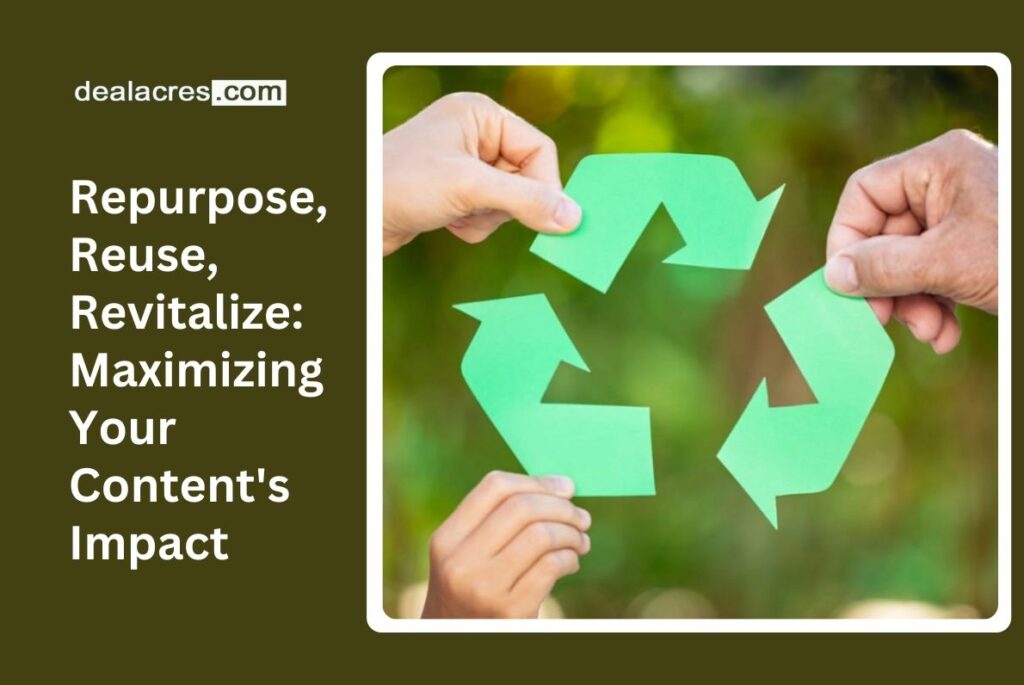Introduction:
In the vast digital realm, creating compelling content is just the beginning. What if there was a way to get more mileage out of your hard work? Enter content repurposing—the art of giving your existing content new life and expanding its reach. In this article, we’ll unravel the secrets of content repurposing in a simple language, exploring how to maximize the value of your content and reach a wider audience.

Understanding Content Repurposing:
- What is Content Repurposing? Content repurposing involves taking existing content and adapting it into different formats or for various platforms. Instead of creating entirely new content from scratch, you breathe fresh air into what you’ve already created, extending its lifespan and widening its impact.
- Why Repurpose Content? The digital world moves fast, and attention spans are short. Repurposing content ensures that your valuable insights, information, and stories don’t get lost in the noise. It allows you to connect with different audience segments and make the most of your efforts.
Maximizing the Value of Your Content:
- Identify Evergreen Content: Begin by identifying evergreen content—pieces that remain relevant over time. These could be in-depth guides, timeless tips, or fundamental insights. Repurposing evergreen content ensures that your core messages continue to resonate with audiences.
- Audit Your Content Library: Take stock of your existing content library. Look beyond blog posts to include videos, podcasts, infographics, and more. Identify pieces with high engagement, valuable information, or untapped potential for repurposing.
- Understand Your Audience: Know your audience inside out. Understand their preferences, where they hang out online, and the formats they prefer. This insight will guide your content repurposing strategy, ensuring it aligns with the habits and preferences of your target audience.
Ways to Repurpose Your Content:
- Transform Blog Posts into Different Formats:
- Create Slide Decks: Summarize key points and visuals for platforms like SlideShare.
- Podcast Episodes: Convert written content into podcast scripts for auditory learners.
- Infographics: Transform data or step-by-step guides into visually appealing infographics.
2. Break Down Comprehensive Guides:
- Blog Series: Turn lengthy guides into a series of blog posts for easy consumption.
- Social Media Snippets: Extract key takeaways to share as bite-sized snippets on social platforms.
3. Convert Webinars and Workshops:
- Create Blog Posts: Summarize webinar content into insightful blog posts.
- Podcast Episodes: Turn recorded webinars into podcast episodes for a broader audience.
4. Repurpose Social Media Content:
- Compile Highlights: Gather top-performing social media posts into a blog post or newsletter.
- Turn Graphics into Slides: Transform visually engaging social media graphics into presentation slides.
5. Update and Re-share Older Content:
- Refresh Statistics: Update outdated statistics or information to breathe new life into old blog posts.
- Share on Social Media: Reintroduce older content to a new audience by resharing on social media platforms.
6. Create Visual Content from Research:
- Infographics: Turn research findings or data into visually appealing infographics.
- Video Summaries: Create short video summaries or animations highlighting key research points.
7. Compile Testimonials and Case Studies:
- Customer Spotlight Blog: Compile customer testimonials into a blog post highlighting success stories.
- Social Media Series: Share individual testimonials as part of a social media series.
8. Host Q&A Sessions:
- Blog Posts: Turn frequently asked questions into informative blog posts.
- Podcast Episodes: Host Q&A sessions as podcast episodes, addressing common queries.
9. Create Engaging Quote Graphics:
- Social Media Quotes: Extract impactful quotes from your content and create eye-catching graphics for social media.
10. Adapt Webinar Content into Courses:
- E-learning Modules: Repurpose webinar content into structured e-learning modules for ongoing education.
- Email Courses: Create email courses by breaking down webinar content into a series of lessons.

Tools to Aid Content Repurposing:
- Canva: Canva is a user-friendly design tool that allows you to create graphics, presentations, and infographics, making it ideal for repurposing content into visually appealing formats.
- Audacity: Audacity is a free, open-source audio editing software. It’s perfect for transforming written content into podcast episodes or audio snippets.
- Descript: Descript is a versatile tool that simplifies audio editing and transcription. It’s handy for refining podcast scripts or creating transcriptions for various content formats.
- Adobe Spark: Adobe Spark is a user-friendly platform for creating visual content, including web pages, graphics, and video stories, making it useful for repurposing content in various visual formats.
- Headliner: Headliner is a tool for creating engaging video content from audio, perfect for repurposing podcast episodes into shareable video snippets.
- Lumen5: Lumen5 is an AI-powered video creation platform that transforms blog posts into engaging video content. It’s particularly useful for repurposing text into visually appealing videos for social media.
Challenges and Considerations:
- Maintain Quality and Relevance: While repurposing, ensure that the quality and relevance of the content are maintained. Update information, fix any outdated references, and adapt the content to suit the current context.
- Avoid Over-repetition: Be mindful of overusing the same content across multiple platforms. While repurposing is valuable, audiences may disengage if they see the exact content repeatedly.
- Tailor for Each Platform: Adapt your repurposed content to fit the nuances of each platform. What works on Instagram might not translate well to LinkedIn. Tailoring ensures that your content resonates with the specific audience on each platform.
- Measure Performance: Regularly measure the performance of your repurposed content. Use analytics tools to track engagement, reach, and conversion rates. This data guides future repurposing strategies.
- Consistent Brand Voice: Maintain a consistent brand voice across all repurposed content. Whether it’s a blog post or a social media graphic, align the language and tone with your brand identity.

Real-Life Examples of Successful Content Repurposing:
- Buffer: Buffer often repurposes its popular blog posts into visually appealing SlideShares. The content, originally in written form, is transformed into engaging presentations, reaching a broader audience on SlideShare.
- HubSpot: HubSpot frequently repurposes its in-depth content into educational webinars. The existing blog posts or guides become the foundation for webinar scripts, allowing the company to connect with audiences in a different format.
- GaryVee: Gary Vaynerchuk, a prominent entrepreneur and marketer, repurposes his long-form video content into shorter clips for social media platforms. These bite-sized clips capture attention on platforms like Instagram and Twitter, driving engagement.
- Neil Patel: Neil Patel, a renowned digital marketer, often repurposes his blog content into podcast episodes. By doing so, he reaches a different audience segment—those who prefer consuming content through auditory channels.
- Red Bull: Red Bull exemplifies content repurposing by leveraging its extensive library of extreme sports content. Videos originally created for YouTube are repurposed into shorter clips for Instagram, longer documentaries for their website, and even as visual content on their energy drink cans.
Conclusion:
Content repurposing is not just a savvy strategy; it’s a superpower in the digital marketing toolkit. By breathing new life into your existing content, you unlock the potential to reach new audiences, reinforce key messages, and make a lasting impact.
In the dynamic world of digital content, where attention is a scarce commodity, repurposing allows you to amplify your voice, connect with diverse audience segments, and maximize the value of your hard work. So, don’t let your valuable insights fade into the background—repurpose, reuse, and revitalize your content for a digital landscape that’s hungry for fresh perspectives.




